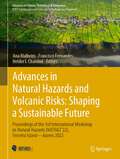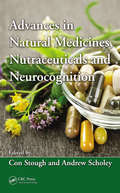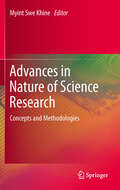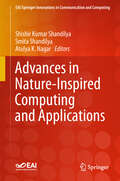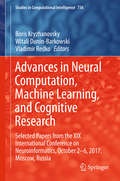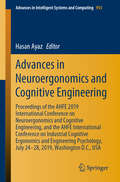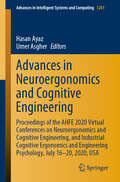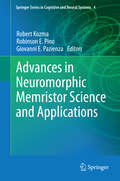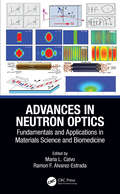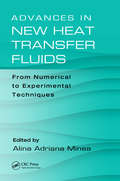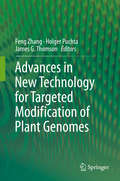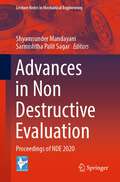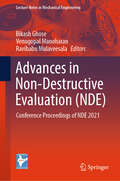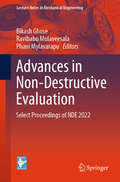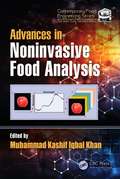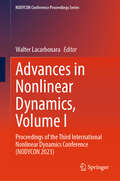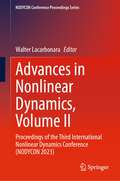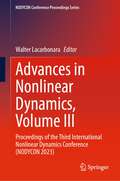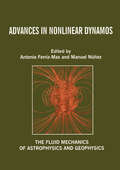- Table View
- List View
Advances in Natural Hazards and Volcanic Risks: Proceedings of the 3rd International Workshop on Natural Hazards (NATHAZ’22), Terceira Island—Azores 2022 (Advances in Science, Technology & Innovation)
by Helder I. Chaminé Francisco Fernandes Ana MalheiroThis book comprises the selected proceedings of the 3rd International Workshop on Natural Hazards (NATHAZ’22), Angra do Heroísmo, Terceira Island, Azores, 2022. The book interests all researchers and practitioners in Earth Sciences, Volcanic Risks, Natural Hazards, Geoethics, Environmental Sciences and Engineering. Terceira is a volcanic island with volcanic systems with caldera (Cinco Picos, Guilherme Moniz, Santa Bárbara and Pico Alto central volcanoes) and an active fissural zone defined by various alignments of small volcanic cones, lava domes and fault zones. The agricultural landscape, the natural and forest reserve, as well as the natural pools make the island a unique place to visit. The historic downtown of Angra do Heroísmo is a UNESCO world heritage, and several iconic buildings witness the island’s geodynamic history. Natural hazards result from a threat of a naturally occurring event that will have a negative effect on humans. That damaging effect is often called natural disasters. Among the natural hazards and potential disasters to be considered are: earthquakes, volcanic eruptions, landslides, subsidence, floods, droughts and coastal erosion. In addition, anthropogenic hazards occur as a result of human interaction with the environment. They comprise technological risks due to exposure to hazardous substances in the environment. Natural systems in different frameworks require a comprehensive understanding of climatology, geology, hydrology and volcanic data, processes and dynamics. Thus, it is important to perform hazard and risk assessment studies to accomplish hazard mitigation. In addition, it highlighted the role of variability and climate change in Earth systems. Furthermore, an accurate understanding of the natural systems and interactions with engineering, geodiversity and natural resources is vital to the entire socioeconomic sector. This book is expected to offer an overview of natural hazards in model regions in Europe, America, Asia and the Atlantic islands. It gives new insights into the characterization, assessment, protection, and modelling of geological hazards, volcanic systems, urban areas, coastal zones and engineering approaches by international researchers and professionals. The scientific committee comprises lead geoscientists, natural hazards related practitioners, and academics worldwide. The main topics include: 1. Multi-hazards and risks: sustainable society, disasters and geoethics 2. Natural hazards and assessment: rock falls, landslides, urban planning and management 3. Sustainable Earth systems: hazards and climate change 4. Terceira Island geology and geodiversity: meeting volcanological hazards in the Azores
Advances in Natural Medicines, Nutraceuticals and Neurocognition
by Con Stough Andrew ScholeyGreat strides have been made in the field of natural medicine with respect to neurocognition. Once limited to the province of niche publications, these discoveries are now routinely explored in mainstream psychopharmacology, neuroscience, nutrition, and medical journals. Now presented in one convenient volume, Advances in Natural Medicines, Nutrace
Advances in Nature of Science Research: Concepts and Methodologies
by Myint Swe KhineThis book consolidates contemporary thinking and research efforts in teaching and learning about the nature of science in science education. The term 'Nature of Science' (NoS) has appeared in the science education literature for many decades. While there is still a controversy among science educators about what constitutes NoS, educators are unanimous in acknowledging the importance of this topic as well as the need to make it explicit in teaching science. The general consensus is that the nature of science is an intricate and multifaceted theme that requires continued scholarship. Recent analysis of research trends in science education indicates that investigation of the nature of science continues to be one of the most prevalent topics in academic publications. Advances in Nature of Science Research explores teaching and assessing the nature of science as a means of addressing and solving problems in conceptual change, developing positive attitudes toward science, promoting thinking habits, advancing inquiry skills and preparing citizens literate in science and technology. The book brings together prominent scholars in the field to share their cutting-edge knowledge about the place of the nature of science in science teaching and learning contexts. The chapters explore theoretical frameworks, new directions and changing practices from intervention studies, discourse analyses, classroom-based investigations, anthropological observations, and design-based research.
Advances in Nature-Inspired Computing and Applications (EAI/Springer Innovations in Communication and Computing)
by Atulya K. Nagar Shishir Kumar Shandilya Smita ShandilyaThis book contains research contributions from leading global scholars in nature-inspired computing. It includes comprehensive coverage of each respective topic, while also highlighting recent and future trends. The contributions provides readers with a snapshot of the state of the art in the field of nature-inspired computing and its application. This book has focus on the current researches while highlighting the empirical results along with theoretical concepts to provide a comprehensive reference for students, researchers, scholars, professionals and practitioners in the field of Advanced Artificial Intelligence, Nature-Inspired Algorithms and Soft Computing.
Advances in Near-Field Optics (Springer Series in Optical Sciences #244)
by Reuven GordonThis book brings together tutorial-style expository chapters on both foundational material and current research areas in near-field optics. The starting point for the book was the Summer School at the 16th International Conference on Near-Field Optics, Nanophotonics and Related Techniques (2022), with each Summer School short course represented by a chapter, along with an additional specially selected chapter on a complementary topic. Together, the chapters within present a modern perspective of the area of near-field optics, focusing on recent theoretical approaches, but also capturing the evolution of the field. Each chapter is written by an internationally-recognized expert and provides a tutorial on a different aspects of the theory and analytical methods for near-field optics, nanophotonics, and plasmonics. While the material will be accessible at the graduate level, it will also provide a useful reference for established researchers in near-field optics and scientists in nearby fields.
Advances in Neural Computation, Machine Learning, and Cognitive Research IV: Selected Papers from the XXII International Conference on Neuroinformatics, October 12-16, 2020, Moscow, Russia (Studies in Computational Intelligence #925)
by Boris Kryzhanovsky Witali Dunin-Barkowski Vladimir Redko Yury TiumentsevThis book describes new theories and applications of artificial neural networks, with a special focus on answering questions in neuroscience, biology and biophysics and cognitive research. It covers a wide range of methods and technologies, including deep neural networks, large scale neural models, brain computer interface, signal processing methods, as well as models of perception, studies on emotion recognition, self-organization and many more. The book includes both selected and invited papers presented at the XXII International Conference on Neuroinformatics, held on October 12-16, 2020, Moscow, Russia.
Advances in Neural Computation, Machine Learning, and Cognitive Research V: Selected Papers from the XXIII International Conference on Neuroinformatics, October 18-22, 2021, Moscow, Russia (Studies in Computational Intelligence #1008)
by Valentin V. Klimov Boris Kryzhanovsky Witali Dunin-Barkowski Vladimir Redko Yury TiumentsevThis book describes new theories and applications of artificial neural networks, with a special focus on answering questions in neuroscience, biology and biophysics and cognitive research. It covers a wide range of methods and technologies, including deep neural networks, large scale neural models, brain computer interface, signal processing methods, as well as models of perception, studies on emotion recognition, self-organization and many more. The book includes both selected and invited papers presented at the XXIII International Conference on Neuroinformatics, held on October 18-22, 2021, Moscow, Russia.
Advances in Neural Computation, Machine Learning, and Cognitive Research: Selected Papers from the XIX International Conference on Neuroinformatics, October 2-6, 2017, Moscow, Russia (Studies in Computational Intelligence #736)
by Boris Kryzhanovsky Witali Dunin-Barkowski Vladimir RedkoThis book describes new theories and applications of artificial neural networks, with a special focus on neural computation, cognitive science and machine learning. It discusses cutting-edge research at the intersection between different fields, from topics such as cognition and behavior, motivation and emotions, to neurocomputing, deep learning, classification and clustering. Further topics include signal processing methods, robotics and neurobionics, and computer vision alike. The book includes selected papers from the XIX International Conference on Neuroinformatics, held on October 2-6, 2017, in Moscow, Russia.
Advances in Neuroergonomics and Cognitive Engineering: Proceedings of the AHFE 2019 International Conference on Neuroergonomics and Cognitive Engineering, and the AHFE International Conference on Industrial Cognitive Ergonomics and Engineering Psychology, July 24-28, 2019, Washington D.C., USA (Advances in Intelligent Systems and Computing #953)
by Hasan AyazThis book offers a broad perspective on the field of cognitive engineering and neuroergonomics, covering emerging practices and future trends toward the harmonious integration of human operators and computer systems. It presents novel theoretical findings on mental workload and stress, activity theory, human reliability, error and risk, and neuroergonomic measures alike, together with a wealth of cutting-edge applications. Further, the book describes key advances in our understanding of cognitive processes, including mechanisms of perception, memory, reasoning, and motor response, with a special emphasis on their role in interactions between humans and other elements of computer-based systems. Based on the AHFE 2019 affiliated conference on Neuroergonomics and Cognitive Engineering, held on July 24-28, 2019, in Washington D.C., USA, it provides readers with a comprehensive overview of the current challenges in cognitive computing and factors influencing human performance.
Advances in Neuroergonomics and Cognitive Engineering: Proceedings of the AHFE 2020 Virtual Conferences on Neuroergonomics and Cognitive Engineering, and Industrial Cognitive Ergonomics and Engineering Psychology, July 16-20, 2020, USA (Advances in Intelligent Systems and Computing #1201)
by Hasan Ayaz Umer AsgherThis book offers broad overview of the field of cognitive engineering and neuroergonomics, covering emerging practices and future trends toward the harmonious integration of human operators and computer systems. It presents novel theoretical findings on mental workload and stress, activity theory, human reliability, error and risk, and a wealth of cutting-edge applications, such as strategies to make assistive technologies more user-oriented. Further, the book describes key advances in our understanding of cognitive processes, including mechanisms of perception, memory, reasoning, and motor response, with a particular focus on their role in interactions between humans and other elements of computer-based systems. Gathering the proceedings of the AHFE 2020 Virtual Conferences on Neuroergonomics and Cognitive Engineering, and Industrial Cognitive Ergonomics and Engineering Psychology, held on 16–20 July 2020, this book provides extensive and timely information for human–computer interaction researchers, human factors engineers and interaction designers, as well as decision-makers.
Advances in Neuroergonomics and Cognitive Engineering: Proceedings of the AHFE 2021 Virtual Conferences on Neuroergonomics and Cognitive Engineering, Industrial Cognitive Ergonomics and Engineering Psychology, and Cognitive Computing and Internet of Things, July 25-29, 2021, USA (Lecture Notes in Networks and Systems #259)
by Hasan Ayaz Umer Asgher Lucas PalettaThis book offers a broad overview of the field of cognitive engineering and neuroergonomics, covering emerging practices and future trends toward the harmonious integration of human operators and computational systems. It gathers both theoretical and practice-oriented studies on mental workload and stress, activity theory, human reliability, error and risk. It covers applications in various field, and corresponding strategies to make assistive technologies more user-oriented. Further, the book describes key advances in our understanding of cognitive processes, including mechanisms of perception, memory, reasoning, and motor response, with a particular focus on their role in interactions between humans and other elements of computer-based systems. Gathering the proceedings of the AHFE 2021 Conferences on Neuroergonomics and Cognitive Engineering, Industrial Cognitive Ergonomics and Engineering Psychology, and Cognitive Computing and Internet of Things, held virtually on July 25-29, 2021, from USA, this book offers extensive information and a thought-provoking guide for researchers and practitioners in cognitive engineering, neuroergonomics and their applications.
Advances in Neuromorphic Memristor Science and Applications (Springer Series in Cognitive and Neural Systems #4)
by Robinson E. Pino Robert Kozma Giovanni E. PazienzaPhysical implementation of the memristor at industrial scale sparked the interest from various disciplines, ranging from physics, nanotechnology, electrical engineering, neuroscience, to intelligent robotics. As any promising new technology, it has raised hopes and questions; it is an extremely challenging task to live up to the high expectations and to devise revolutionary and feasible future applications for memristive devices. The possibility of gathering prominent scientists in the heart of the Silicon Valley given by the 2011 International Joint Conference on Neural Networks held in San Jose, CA, has offered us the unique opportunity of organizing a series of special events on the present status and future perspectives in neuromorphic memristor science. This book presents a selection of the remarkable contributions given by the leaders of the field and it may serve as inspiration and future reference to all researchers that want to explore the extraordinary possibilities given by this revolutionary concept.
Advances in Neurotechnology, Electronics and Informatics: Revised Selected Papers from the 2nd International Congress on Neurotechnology, Electronics and Informatics (NEUROTECHNIX 2014), October 25-26, Rome, Italy (Biosystems & Biorobotics #12)
by Ana Rita Londral Pedro EncarnaçãoThis book is a timely report on current neurotechnology research. It presents a snapshot of the state of the art in the field, discusses current challenges and identifies new directions. The book includes a selection of extended and revised contributions presented at the 2nd International Congress on Neurotechnology, Electronics and Informatics (NEUROTECHNIX 2014), held October 25-26 in Rome, Italy. The chapters are varied: some report on novel theoretical methods for studying neuronal connectivity or neural system behaviour; others report on advanced technologies developed for similar purposes; while further contributions concern new engineering methods and technological tools supporting medical diagnosis and neurorehabilitation. All in all, this book provides graduate students, researchers and practitioners dealing with different aspects of neurotechnologies with a unified view of the field, thus fostering new ideas and research collaborations among groups from different disciplines.
Advances in Neutron Optics: Fundamentals and Applications in Materials Science and Biomedicine (Multidisciplinary and Applied Optics)
by Maria L. Calvo Ramon F. Alvarez-EstradaNeutron optics studies the interactions of a beam of slow neutrons with matter. This book updates various advances on neutron optics. There will be a focus on the very active topics of neutron imaging (NI) and neutron spin optics (NSO). The book will also present applications of neutron beams in biomedicine, such as Boron Neutron Capture Therapy (BNCT) and related techniques. Features: Discusses diffraction and interference of slow neutrons, including computational approaches Reviews neutron imaging (NI) and neutron spin optics (NSO) Treats two major sources of slow neutron beams: (1) fission reactions at nuclear reactors and (2) collisions in particle accelerators (small ones, spallation sources) of charged particle beams with targets of heavy atoms Selects subjects on fundamental quantum aspects of slow neutrons and on confined propagation and waveguiding thereof Updates slow neutron beams and BNCT
Advances in New Heat Transfer Fluids: From Numerical to Experimental Techniques (Heat Transfer)
by Alina Adriana MineaHeat transfer enhancement has seen rapid development and widespread use in both conventional and emerging technologies. Improvement of heat transfer fluids requires a balance between experimental and numerical work in nanofluids and new refrigerants. Recognizing the uncertainties in development of new heat transfer fluids, Advances in New Heat Transfer Fluids: From Numerical to Experimental Techniques contains both theoretical and practical coverage.
Advances in New Technology for Targeted Modification of Plant Genomes
by Feng Zhang James G. Thomson Holger PuchtaOver the past 50 years, biotechnology has been the major driving force for increasing crop productivity. Particularly, advances in plant genetic engineering technologies have opened up vast new opportunities for plant researchers and breeders to create new crop varieties with desirable traits. Recent development of precise genome modification methods, such as targeted gene knock-out/knock-in and precise gene replacement, moves genetic engineering to another level and offers even more potentials for improving crop production. The work provides an overview of the latest advances on precise genomic engineering technologies in plants. Topics include recombinase and engineered nucleases-mediated targeted modification, negative/positive selection-based homologous recombination and oligo nucleotide-mediated recombination. Finally, challenges and impacts of the new technologies on present regulations for genetic modification organisms (GMOs) will be discussed.
Advances in Non Destructive Evaluation: Proceedings of NDE 2020 (Lecture Notes in Mechanical Engineering)
by Shyamsunder Mandayam Sarmishtha Palit SagarThis book comprises the proceedings of the Conference and Exhibition on Non Destructive Evaluation (NDE 2020). The contents of the volume encompass a vast spectrum from Conventional to Advanced NDE including novel methods, instrumentation, sensors, procedures, and data analytics as applied to all industry segments for quality control, periodic maintenance, life estimation, structural integrity and related areas. This book will be a useful reference for students, researchers and practitioners.
Advances in Non-Destructive Evaluation: Conference Proceedings of NDE 2021 (Lecture Notes in Mechanical Engineering)
by Ravibabu Mulaveesala Bikash Ghose Venugopal ManoharanThis book comprises the proceedings of the Conference and Exhibition on Non-Destructive Evaluation (NDE 2021) organised by the Indian Society for Non-destructive Testing (ISNT). This book covers topics from wide domains from conventional to advanced NDE, including conventional and advanced NDE methods, drone-based inspections, thermal wave imaging, NDT data fusion, material characterization, waveguide sensors, inspections of civil structures, medical applications such as bone density and cancer diagnosis, periodic maintenance, life estimation, as well as structural integrity and related areas. This book serves as a useful reference for students, researchers, and practitioners alike.
Advances in Non-Destructive Evaluation: Select Proceedings of NDE 2022 (Lecture Notes in Mechanical Engineering)
by Ravibabu Mulaveesala Bikash Ghose Phani MylavarapuThis book comprises the proceedings of the Conference and Exhibition on Non-Destructive Evaluation (NDE 2022). The contents of the volume encompass a vast spectrum from conventional to advanced NDE including novel methods, and emerging NDE technologies. It covers topics from wide domains from conventional to advanced NDE methods which includes but not limited to drone-based inspections, thermal wave imaging, microwave NDE, shearography, Quantitative NDE using Digital Image Correlation, modeling and simulation, NDT data fusion, material characterization, waveguide sensors, inspections of civil structures, medical applications such as bone density and cancer diagnosis, signal and image processing, NDE sensors, instrumentation, software and systems, NDE 4.0 and robotics, automation, AI in NDE, functional and operational testing, NDE data analytics, reliability and safety assurance, periodic maintenance, life estimation, as well as structural integrity and related areas. This book serves as a useful reference for students, researchers, and practitioners working in the areas of non-destructive testing and evaluation.
Advances in Noninvasive Food Analysis (Contemporary Food Engineering)
by Muhammad Kashif Iqbal KhanTo ensure food quality and safety food, professionals need a knowledge of food composition and characteristics. The analysis of food product is required for quality management throughout the developmental process including the raw materials and ingredients, but food analysis adds processing cost for food industry and consumes time for government agencies. Advances in Noninvasive Food Analysis explores the potential and recent advances in non-invasive food analysis techniques used to ensure food quality and safety. Such cost-reducing and time-saving non-destructive food analysis techniques covered include, Infrared, Raman Spectroscopy, and Nuclear Magnetic Resonance. The book also covers data processing and modelling. Features: Covers the advent of non-invasive, non-destructive methods of food analysis Presents such techniques as near and mid infrared, Raman Spectroscopy, and Nuclear Magnetic Resonance Describes the growing role of nanotechnology in non-invasive food analysis Includes image analysis and data processing and modelling required to sort out the data The prime for this book are food professionals working in industry, control authorities and research organizations that ensure food quality and safety as well as libraries of universities with substantial food science programs, food companies and food producers with research and development departments. Also available in the Contemporary Food Engineering series: Advances in Food Bioproducts, Fermentation Engineering and Bioprocessing Technologies , edited by Monica Lizeth Chavez Gonzalez, Nagamani Balagurusamy, Christobal N. Aguilar (ISBN 9781138544222) Advances in Vinegar Production, edited by Argyro Bekatorou (ISBN 9780815365990) Innovative Technologies in Seafood Processing, edited by Yesim Ozogul (ISBN 9780815366447)
Advances in Nonlinear Dynamics and Control of Mechanical and Physical Systems: Selected Articles from CSNDD 2023; 15–17 May; Marrakesh, Morocco (Springer Proceedings in Physics #301)
by Mohamed BelhaqThis book highlights recent advances in nonlinear dynamics and control with applications in mechanics and physics. The book includes selected articles from the 5th Conference on Structural Nonlinear Dynamics and Diagnosis (CSNDD 2023) and presents recent theoretical, experimental and numerical findings covering various topics in nonlinear structural dynamics and diagnosis. The main topics includes multiple scales dynamics, energy harvesting, dynamics of MEMS, NEMS and AFM, systems with time delay, quasi-periodic oscillations and synchronization, stochastic dynamics, analytical and semi-analytical methods, time series analysis, control and analysis of switching systems, structural health monitoring, nonlinear vibrations of structures, nonsmouth dynamics, nonlinear phenomena in discrete and continuum systems, dynamic modeling and fault diagnosis, constrained multi-catenary systems, conservative chaotic system, hysteretic structures, and nonlinear PDEs and their dynamics.
Advances in Nonlinear Dynamics, Volume I: Proceedings of the Third International Nonlinear Dynamics Conference (NODYCON 2023) (NODYCON Conference Proceedings Series)
by Walter LacarbonaraThis volume aims to present the latest advancements in experimental, analytical, and numerical methodologies aimed at exploring the nonlinear dynamics of diverse systems across varying length and time scales. It delves into the following topics:Methodologies for nonlinear dynamic analysis (harmonic balance, asymptotic techniques, enhanced time integration)Data-driven dynamics, machine learning techniquesExploration of bifurcations and nonsmooth systemsNonlinear phenomena in mechanical systems and structuresExperimental dynamics, system identification, and monitoring techniquesFluid-structure interactionDynamics of multibody systemsTurning processes, rotating systems, and systems with time delays
Advances in Nonlinear Dynamics, Volume II: Proceedings of the Third International Nonlinear Dynamics Conference (NODYCON 2023) (NODYCON Conference Proceedings Series)
by Walter LacarbonaraThis second of three volumes presents papers from the third series of NODYCON to be held in June of 2023. The conference papers reflect a broad coverage of topics in nonlinear dynamics, both traditionally placed in established streams of research as well as they stand as newly explored and emerging venues of research. These include• Multi-scale dynamics: multiple time/space scales, large system dynamics• Experimental dynamics: benchmark experiments, experimental methods,instrumentation techniques, measurements in harsh environments, experimentalvalidation of nonlinear models• Reduced-order modeling: center manifold reduction, nonlinear normal modes, normalforms• Systems with time and/or space delays• Nonlinear interactions in multi-dof systems: parametric vibrations, multiple external andautoparametric resonances.• Computational techniques: efficient algorithms, use ofsymbolic manipulators, integrationof symbolic manipulation and numerical methods, use of parallel processors.• Nonlinear system identification: parametric/nonparametric identification, data-drivenidentification• Multibody dynamics: rigid and flexible multibody system dynamics, impact and contactmechanics, tire modeling, railroad vehicle dynamics, biomechanics applications,computational multibody dynamics• Fluid/structure interaction• Nonlinear wave propagation in discrete and continuous media
Advances in Nonlinear Dynamics, Volume III: Proceedings of the Third International Nonlinear Dynamics Conference (NODYCON 2023) (NODYCON Conference Proceedings Series)
by Walter LacarbonaraThis third of three volumes presents papers from the third series of NODYCON to be held in June of 2023. The conference papers reflect a broad coverage of topics in nonlinear dynamics, both traditionally placed in established streams of research as well as they stand as newly explored and emerging venues of research. These include• Multi-scale dynamics: multiple time/space scales, large system dynamics• Experimental dynamics: benchmark experiments, experimental methods,instrumentation techniques, measurements in harsh environments, experimentalvalidation of nonlinear models• Reduced-order modeling: center manifold reduction, nonlinear normal modes, normalforms• Systems with time and/or space delays• Nonlinear interactions in multi-dof systems: parametric vibrations, multiple external andautoparametric resonances.• Computational techniques: efficient algorithms, use ofsymbolic manipulators, integrationof symbolic manipulation and numerical methods, use of parallel processors.• Nonlinear system identification: parametric/nonparametric identification, data-drivenidentification• Multibody dynamics: rigid and flexible multibody system dynamics, impact and contactmechanics, tire modeling, railroad vehicle dynamics, biomechanics applications,computational multibody dynamics• Fluid/structure interaction• Nonlinear wave propagation in discrete and continuous media
Advances in Nonlinear Dynamos (The Fluid Mechanics of Astrophysics and Geophysics #1)
by Manuel Núñez Antonio Ferriz-MasNonlinear dynamo theory is central to understanding the magnetic structures of planets, stars and galaxies. In chapters contributed by some of the leading scientists in the field, this text explores some of the recent advances in the field. Both kinetic and dynamic approaches to the subject are considered, including fast dynamos, topological methods in dynamo theory, physics of the solar cycle and the fundamentals of mean field dynamo. Advances in Nonlinear Dynamos is ideal for graduate students and researchers in theoretical astrophysics and applied mathematics, particularly those interested in cosmic magnetism and related topics, such as turbulence, convection, and more general nonlinear physics.
